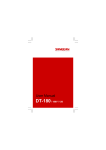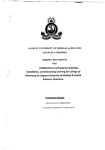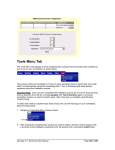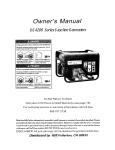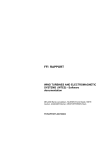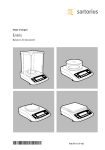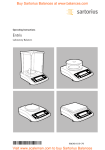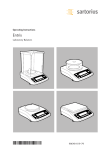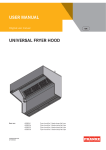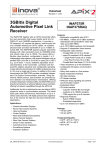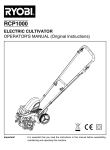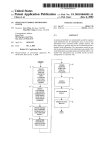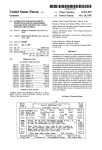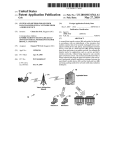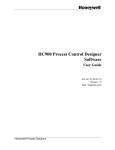Download Better register
Transcript
US 20040236678A1 (19) United States (12) Patent Application Publication (10) Pub. No.: US 2004/0236678 A1 (43) Pub. Date: Johns et al. (54) BETTER REGISTER Nov. 25, 2004 Publication Classi?cation (76) Inventors: Beverly Jane Johns, EdgeWood, NM (US); Richard Harold Krukar, (51) Int. Cl? ................................................... .. G06F 17/60 Albuquerque, NM (US) (52) Us. 01. .............................................................. .. 705/38 Correspondence Address: (57) RICHARD KRUKAR 4717 BALI CT NE ALBUQUERQUE, NM 87111 (US) (21) Appl. No.: 10/845,376 (22) Filed: May 13, 2004 A ?nancial data tracking tool incorporating 10 tools is presented. The 10 tools include 4 ledgers, a budget tracker, an account information tracker, a balance tracker, an auto matic payment reminder, a bill tracker, and a life energy tracker. An important feature of the invention is that it is easy to carry While still incorporating all 10 tools. The speci?c Related US. Application Data (60) ABSTRACT Provisional application No. 60/473,227, ?led on May 24, 2003. embodiment of the invention can be a printed booklet or computer softWare running on hardWare such as a cell phone. Tool 1: Info Tracker ACCT NAME OF LENDING INSTITUTION LAST 4 PHONE NO FOR PURCH FOR CI‘SH 1 2 3 4 5 6 7 5! We recommend you fill out the Info Tracker (on the second to last page of the register) as your ?rst step. The Info Tracker is a great start because it helps you get your financial information organized. As you use The Better Register daily, you will find the info Tracker is a convenient way to keep track of your credit card and loan information. Gather all your credit card statements and loan papers before you begin. The Info Tracker has ?elds for up to 8 different accounts. 1. The Account No. column identifies your accounts by number. (These 8 account numbers are needed when you use the Balance Tracker. See p. 12). Write the name of the account and the type of card/loan in the Name column. For security. write only the Last 4 Digits of your account in this column. Write your Customer Service Phone Number in this column. Read your credit card statements carefully and write your Interest Rate for Purchases (APRs) here. If there is a letter code for the calculation method, include it here (Example: G). (For details, see Tutorial 5 at itseasytodoeom) 6. Do the same for your interest Rate for Cash Advances. 7. Write the number of Days in the Billing Cycle (or the due date) here. 11 Patent Application Publication Nov. 25, 2004 Sheet 1 0f 11 AQQT NC). NAME OF LENDING INSTITUTION / LAST 4 US 2004/0236678 A1 CUSTOMER SVC INT RATE °/o INT RATE °/u PHONE NO FOR PURCH FOR CASH Figure 1 DAYS CYCLE Patent Application Publication Nov. 25, 2004 Sheet 2 0f 11 US 2004/0236678 A1 Tool 1: Info Tracker ACCT r40. NAME OF LENDlNG INSTITUTION LAST 4 W PHONE NO FOR PURCH FOR CASH CYCLE i 2 3 4 5 6 2 7 8 We recommend you fill out the Info Tracker (on the second to last page of the register) as your ?rst step. The info Tracker is a great start because it helps you get your financial information organized. As you use The Better Register daily, you 10 MW...” will find the info Tracker is a convenient way to keep track of your credit card and loan information. Gather all your credit card statements and loan papers before you begin. The Info Tracker has ?elds for up to 8 different accounts. ‘lo The Account No. column identifies your accounts by number. (These 8 account numbers are needed when you use the Balance Tracker. See p. 12). Write the name of the account and the type of card/loan in the Name column, For security, write only the Last 4 Digits of your account in this column. Write your Customer Service Phone Number in this column. Read your credit card statements carefully and write your Interest Rate for Purchases (APRs) here. If there is a letter code for the calculation method, include it here (Example: 6). (For details, see Tutorial 5 at itseasytodocom) Do the same for your lnterest Rate for Cash Advances. Write the number of Days in the Billing Cycle (or the due date) here. 11 Figure 2 7 .J Patent Application Publication Nov. 25, 2004 Sheet 3 0f 11 BALANCES ON ACGTS: N0. 1 N0. 2 NOv 3 N0. 4 MONTH: MONTH: MONTH, Figure 3 NO. 5 N0. 6 US 2004/0236678 A1 N0, 7 N0. 8 Patent Application Publication Nov. 25, 2004 Sheet 4 0f 11 US 2004/0236678 A1 Tool 2: Balance Tracker BAMHCES ON ACCTS: ' MONTH. ND. 1 No. 5 L m. e No 1 No. 5 C3 MONTH: MONTH: The Balance Tracker is directly below the Info Tracker (on the second to last page of the register). Here is where you will write the monthly balances for each of the accounts you listed in The info Tracker. Remember, column 0 of the info Tracker is the Account No. column. The Balance Tracker uses these 8 account numbers on its top row. For example, My Bank Visa Card is Account No. 1 in the info Tracker. Balances for this account 90 in the N0. 1 column of the Balance Tracker 12 8, The top Month current firstmonth step field, inisusing followed September, the by Balance the write names Sept. Tracker ofinnext isthe to 2top write months. field thefollowed current For example, month by Oct,in if Nov. the the 9. The next step is to call the customer service number for Account No. 1 (in this example, My Bank Visa Card). Ask for your current balance, and write it in the No. 1 field for the current month (Sept). USE A PENCIL to write your current balances. These balances may change later at the end of this month when you receive your credit card or loan statement. 10. Do the same for Account No. 2 (in this example, Ci’riOrg Master-Cord). 11. Continue for all of your accounts listed in the lnfo Tracker. 12. When you receive your statement after the end of this month, check your actual balances. If they have changed, rewrite them. 13, For future months, write the balances that are printed on your statements. 13 Figure 4 Ti i Patent Application Publication Nov. 25, 2004 Sheet 5 0f 11 US 2004/0236678 A1 Track Your Bills, Due Dates, and Automatic Payments I Direct Deposits’ Month Sun W? " ' TIQIIW" 21:? Mon Tue m Wed ..... Y; Month Thu Fri .... i 1 ____l Sun Mi J J Figure 5 Mon ii Tue Wed Thu Fri Sat L. .1 _J' .J -1 -J mi Q] mi M Patent Application Publication Nov. 25, 2004 Sheet 6 0f 11 US 2004/0236678 A1 Tool 3: Bill Tracker Track Your Bills, Due Dates, and Automatic Payments I Direct Deposits Mc'mh 5e VOLSun Mon Tue '2€l*""2;2‘“““2“3"' yWed Thu £25 Month Fri 26 Sat 27 2.8 5.! 19 12 ((3 2.9 6.5 g3, _.Qit;3.0 14 at Cable<21 152 """ "2.3"221 1.6 .9‘ ""10 17 3.‘ Payday payday **** ‘l 11 Payday Oct/Nov Tue Wed Thu "1 Sun Mon Z6 Z7 Z8 Z9 .2 v16 623i. 10 2.4 .3 11 fl85 12"""13 1.9@@ r, Z0 .Q7 ‘213 ‘z3""“"f2jg"'— 21 ‘ 5'7‘8) 30 Fri 31 Sat i i t 14 While you have your credit card statements out, turn to the inside back cover of The Better Register and fill out your Bill Tracker calendar. Start with today's date. (You can use the pre-printed calendar on the back of The Better Register to look up the dates.) On the dates that your credit cards, loans, and other bills are due, write the Account No. (from the Info Tracker) or the name of the bill. Using the Info Tracker account numbers saves space in the Bill Tracker. Cross referencing also helps to remind you to update your Balance Tracker each month. All 10 tools of The Better Register are designed to work together. As you'll see throughout this booklet and in the testimonials and tutorials on our Web site, it is the synergy‘ of these 10 tools that helps you to gain control over your money NATURALLY, simply by using The Better Register. isynergy means “working together to create a whole that's more powerful than the sum of its parts" 15 Figure 6 f; I‘) Patent Application Publication Nov. 25, 2004 Sheet 7 0f 11 AUTOMAI Ir; TRANSACTION Raim?béii Record automatic and withdrawals for DATE ACCOUNT DESCRIPTiON AMOUNT Figura 7 MO‘ US 2004/0236678 A1 . and credit ENT MU. . ENT Patent Application Publication Nov. 25, 2004 Sheet 8 0f 11 US 2004/0236678 A1 Tool 4: Automatic Transaction Reminder AMOUNT DESCRIPTION ACC OUNT ENT MO. ENT ki T st l nter'net ice i iso X Oct ct iti Now that you have entered all your bills, automatic payments, direct deposits, and important dates into the Bill Tracker, you should fill out the Automatic Transaction Reminder (last page of the register). This tool is for any payments or deposits that are automatically posted to your checking, savings, or credit card accounts. 16 Although some of these transactions may aiso appear in the Bill Tracker, writing the entries here reinforces your awareness of them. Also, “hidden“ costs such as service charges or member insurance fees may otherwise be missed if they are not entered here. (Look for them on your statements.) Quarterly, semi-annual, and annual transactions may also be recorded so you can better prepare for them. 14. Enter the Date that the automatic transaction is posted each month. 15. Enter a Description of the transaction. 16. Enter the Amount of the transaction. Don’t forget the plus (+) sign for auto matic deposits, and the minus sign (-) for automatic payments/withdrawals. 17. Enter the Account (checking, savings, credit) to which the transaction posts. 18, Enter the current month (Sept) and the next 2 months in the Mo. fields. 19. ONLY AFTER you have entered the transaction in your Better Register ledgers, piece an “X" in the Entered field. (See “Intro to Ledgers” on p. 18.) 17 Figure 8 Patent Application Publication Nov. 25, 2004 Sheet 9 0f 11 DATE CATEGORY NO. or CLR 3‘ CODE REC ‘F Figure 9 US 2004/0236678 A1 Patent Application Publication Nov. 25, 2004 Sheet 10 0f 11 US 2004/0236678 A1 Intro to Ledgers and Other Tools - . at . _ SAVtHGS MMMMMM I‘ a 20. Enter the date of the transaction in the Date ?eld. 21. Enter the name of the payee to whom you are writing a check, paying cash, etc, in the Payee/Description field. if there is no payee (for example, if you are making a transfer or a deposit. or you are recording the cash you spent in a candy bar machine), use this field to describe the transaction. For example: “Transfer to Savings," "Paycheck Deposit.” or "Snack Machine at Work.” 22. Enter your own budget tracking categories in the Category field. 18 23. Enter a check number or transaction code (p. 39) in the No. or Code ?eld. 24. When your transaction has cleared (when it’s printed on your bank statement, or via online banking, or by phone), place a check mark in the CLR field. 25. When you record your transaction in your budget book or financial software (such as Quicken), place an "X" in the REC field. Or. if you are following the YMOYL financial program enter your Life Energy Spent (LE) here (see p. 35). 26. This column is the CheckinglDebit Card Account Ledger. > 27. This column is the Cash Account Ledger. lt tracks the cash in your wallet. 28. This column is the Savings Account Ledger. 29. This column is the Credit Cards (or Loans) Account Ledger. 30. The first row of each page is for your balance forward (or starting balance). 31. The top (white) rows are where you enter your transaction amounts. 32. The bottom (gray) rows are for your balances (they run down each column). 19 Figure 10 Patent Application Publication Nov. 25, 2004 Sheet 11 0f 11 US 2004/0236678 A1 Tool 5: Checking/Debit Card Account Led er CHECKlNG DEE" cnrzo DAT [ 2 ‘ REC CATEGORY : 4 @1 +4 @1 + @ wt weft nter‘toi Number '20 I See “Putting It All Together“ on o. 36. 33. TheChecking/Debit Card Account Ledger runs straight down this column. 34. Begin by entering your starting balance here. (For a tutorial on calculating your starting balance, read The Better Register FAQ at itseasytodocom or see the instructions on the back of your bank statement under “Reconcile ") 35. in this transaction, werentered the Date (Sept 14), the Payee (Alex's ' Restaurant), our budget category (Food out), and the Code that describes the transaction method (DEB for debit card). The check mark in the CLR field means the charge has posted to the account (cleared), and the means we recorded it in our budget book or financial software (e.g., Quicken). ' 36. We ‘enter the amount (12.73) in the top (white) field of the ledger. We include a minus sign (-) to show that it is subtracted from the account. 37. We subtract the 12.73 from our starting balance (742.70) for a new balance of 729.97. We enter the new balance in the bottom (gray) field of the ledger. 21 WW .. .7. A." .. w I. D, . M» 38. Here is an example of a deposit entry for a paycheck. it fits our budget book or financial software Category called lncome. Note that a plus (+) sign is placed in front of deposit amounts to help prevent arithmetic errors. 39. Here is another example of Income. This income is from a merchandise return at our Favorite Department Store. ln this example, the original pur chase was made with a debit card. The store credited the debit card, so it will be entered in the ledger as a deposit to the checking/debit card account. 40. This is an example of writing a check to pay a bill (in this case, our cable bill). The check number (704) is written in the No. or Code column. 41. Here is an Automatic Transaction (Auto) that posts each month to our checking account. An is placed in the Automatic Transaction Reminder (see @ on p.16) when the Auto payment is entered here in the ledger. Only after the transaction clears thevbank is a check mark placed in the CLR field. 22 Figure 11 Nov. 25, 2004 US 2004/0236678 A1 BETTER REGISTER someone can gather together all his or her ?nancial data into CROSS-REFERENCE TO RELATED APPLICATIONS on hand an understandable picture of their oWn ?nances. For a small convenient package, carry it, maintain it, and have [0001] The present invention Was previously disclosed as provisional patent 60/473227 titled “Better register for easily tracking cash How and net Worth”. STATEMENT OF GOVERNMENT INTEREST many people, The Better Register is the only Way they Will ever be able to control their ?nances and tame they buying impulse. BRIEF SUMMARY OF THE INVENTION [0008] The Better Register is a set of ten tools combined [0002] No government funding, from any government, has into a single convenient and handy package. gone into the development of the present invention. There is [0009] no government interest in this invention. ing loan or credit account data including lending institution, purchase interest rate, cash interest rate, days in billing FIELD OF THE INVENTION [0003] The present invention relates to the ?eld of ?nan cial data tracking tools. Financial data tracking tools are typically used to track the How of money to and from an organiZation or individual. More speci?cally, the present invention is a ?nancial data tracking tool that is both handy The ?rst tool is an information tracker for record cycle, customer service number, and a reference to the account number. [0010] The second tool is a balance tracker Wherein peri odic balances are recorded for the accounts recorded in the information tracker. and able to track information, such as the life energy costs [0011] of transactions, that is not normally tracked in a single useful tool. for bills are recorded. BACKGROUND OF THE INVENTION [0004] Financial data tracking tools (FDTTs) are common items With a history extending back to the invention of Writing. Originally, even the ability to track the information Was neW. Enormous amounts of ?nancial data are noW tracked and a Whole industry, the accounting industry, exists to perform the function. HoWever, even With all of today’s advanced techniques and computeriZation almost no indi vidual person is capable of generating a marginally accurate picture if their oWn Wealth and cash ?oWs. Additionally, corporations, accountants, and Wealthy individuals are com fortable in tracking everything, including labor, as a mon etary expense. For a layperson, labor is more than an expense; it is the sWeat of their oWn broW and the minutes of their life ?oWing aWay and never to return. The third tool is a bill tracker Wherein the due dates [0012] The fourth tool is an automatic transaction reminder Wherein the transaction dates for automatic ?nan cial transactions are recorded. [0013] The ?fth tool is for checking accounts. The ?fth tool has at least one checking account ledger Wherein ?nancial transactions involving a checking account are recorded. [0014] The sixth tool is a cash account ledger Wherein ?nancial transactions involving actual currency on hand are recorded. [0015] The seventh tool is for savings accounts. The seventh tool has at least one savings account ledger Wherein ?nancial transactions involving a savings account are recorded. [0016] The eighth tool is for credit cards. The eighth tool has at least one credit cards and loans account ledger [0005] Most people desiring to track their ?nances create budgets. A budget is a formalism in Which areas of some one’s life are categoriZed and assigned an alloWable periodic ?nancial expenditure. Budgets are good tools for creating plans, but are notoriously unreliable in leading people aWay Wherein ?nancial transactions involving credit cards and loans are recorded. [0017] The ninth tool is a budget tracker Wherein the transactions recorded in the ledgers are assigned to a budget from ?nancial problems. The reason is that budgets are not category. good at telling people hoW hard they Worked for each line item in their budget. [0018] The tenth tool is a life energy tracker Wherein the transactions recorded in a ledger, Which are recorded in [0006] There are many systems, some patented, for track ing ?nancial data. There are computeriZed systems for individuals, such as the Quicken product from Intuit. There terms of money, are also recorded and tracked in terms of life energy spent. [0019] A distinguishing aspect of the invention is that all are paper based products such as described in US. Pat. No. 5,882,041. These are all excellent systems for What they are intended. HoWever, they are not suf?cient for helping a person Who is ?nancially unsophisticated to develop an understandable picture of their oWn ?nances and express that picture in terms that matter. What matters is Where the ten tools are present. One Way to use the invention is to create a form or table for use With each tool, print the forms or tables, and bind them together to form a convenient package. Another Way to use the tool is as a graphical user money is going by identifying the little items upon Which cash is squandered. What matters is understanding hoW hard BRIEF DESCRIPTION OF THE DRAWINGS and hoW long it Was to get the cash that Was squandered. [0007] The Better Register (TBR) is a tool for the layper interface used in conjunction With a computer database. [0020] FIG. 1 shoWs an information tracking tool pre sented as a table on a printed form. son to use for creating and keeping an accurate and com [0021] prehensible picture of their ?nances. It is a tool With Which user manual. FIG. 2 shoWs pages 10-11 of The Better Register Nov. 25, 2004 US 2004/0236678 A1 [0022] FIG. 3 shows a balance tracking tool presented as a table on a printed form. [0023] FIG. 4 shoWs pages 12-13 of The Better Register user manual. [0024] FIG. 5 shoWs a bill tracker presented as a calendar on a printed form. [0025] FIG. 6 shoWs pages 14-15 of The Better Register user manual. [0026] FIG. 7 shoWs an automatic transaction reminder contain important information for account number 1. Col umn 1 in the balance tracker Would contain the account balance at the end of each time period. An eXample of a time is “May 2004” in Which case the balance recorded is the amount of money in the account on May 31, 2004. Other embodiments of the invention can alloW for different num bers of accounts and a different number of time periods. FIG. 4 shoWs pages 12-13 of The Better Register users manual. Those pages contain the instructions for using the balance tracker in that embodiment of the invention. presented as a table on a printed form. [0034] The third tool is a bill tracker Wherein the due dates for bills are recorded. FIG. 5 shoWs the bill tracker in the [0027] current Better Register product. The Figure shoWs tWo FIG. 8 shoWs pages 16-17 of The Better Register user manual. [0028] FIG. 9 shoWs a transaction ledger presented as a table on a printed form. The transaction ledger contains a check ledger, cash ledger, savings ledger, credit card and loan account ledger, a budget tracker, and a life energy tracker. [0029] FIG. 10 shoWs pages 18-19 of The Better Register user manual. [0030] FIG. 11 shoWs pages 20-22 of The Better Register user manual. DETAILED DESCRIPTION OF THE INVENTION [0031] The present invention is a set of ten tools combined into a single convenient and handy package. Every tool in the set can take the form of a table printed on a piece of paper. The Better Register product as currently produced is a grouping of tables printed on paper and folded longitudi nally. The present invention is not limited to the physical form of the current Better Register product, but the ?gures included in this patent speci?cation are all taken from that product. [0032] The ?rst tool is an information tracker for record ing loan or credit account data. Information that can be recorded for each account in the information tracker includes lending institution, purchase interest rate, cash interest rate, days in billing cycle, customer service number, and a reference to the account number. FIG. 1 shoWs the information tracking table in the current Better Register product. In FIG. 1, each roW can contain the information for one account. Therefore, the ?rst roW in the table can contain information for account 1 While roW 2 can contain the information for account 2. The table in FIG. 1 has 8 roWs and can therefore contain information for 8 accounts. Other embodiments of the invention can alloW recording of infor mation for different numbers of accounts. FIG. 2 shoWs pages 10-11 of The Better Register users manual. Those identical tables. Each table contains 5 roWs. Each roW is divided into seven sections corresponding to a day of the Week. Each section has a small square in the upper left corner Where the day of the month can be Written. The rest of the section is a space Wherein the details of scheduled payments can be entered. FIG. 6 shoWs pages 14-15 of The Better Register users manual. Those pages contain the instructions for using the bill tracker in that embodiment of the invention. [0035] The fourth tool is an automatic transaction reminder Wherein the transaction dates for automatic ?nan cial transactions are recorded. FIG. 7 shoWs the automatic transaction reminder in the current version of The Better Register. It contains information about automatic transac tions and may duplicate information in the bill tracker. The information recorded for each automatic transaction com prises the day in the billing period, a description of the transaction, the transaction amount, the account to Which the transaction posts, as Well as some information for certain billing periods. The information for certain billing periods comprises the name of the billing period and a place to note if the transaction has been entered into a ledger. FIG. 8 shoWs pages 16-17 of The Better Register users manual. Those pages contain the instructions for using the automatic transaction reminder in that embodiment of the invention. [0036] The remaining 6 tools are either ledgers or closely associated With ledgers. Aledger is used to track the balance, Which is usually the amount of money, in an account or a group of accounts. A ledger entry comprises a transaction date, transaction description, transaction amount, and account balance. Ledgers usually have an initial entry for the initial balance. FIG. 9 shoWs a page from the current version of The Better Register’s transaction register. The transaction register contains all 6 of the remaining tools. FIG. 10 shoWs pages 18-19 of The Better Register users manual. Those pages contain a very brief introduction to the 4 ledger tools, the budget tracker, and the life energy tracker. [0037] The ?fth tool is for checking accounts. The ?fth pages contain the instructions for using the information tracker in that embodiment of the invention. tool has at least one checking account ledger Wherein ?nancial transactions involving checking accounts are [0033] recorded. FIG. 9 shoWs the checking account ledger in the current version of The Better Register. In this particular embodiment, the checking account ledger is combined With The second tool is a balance tracker Wherein peri odic balances are recorded for the associated accounts in the information tracker. FIG. 3 shoWs the balance tracking table in the current Better Register product. Each roW in the table represents a single time period. In FIG. 3, the time period is one month. The columns in the table are labeled No. 1 through No. 8. Each column in the balance tracker corre sponds to a roW in the information tracker. Referring to FIG. 1 and FIG. 3, roW 1 in the information tracker of Would 5 other tools. FIG. 11 shoWs pages 20-222 of The Better Register users manual. Those pages contain detailed instruc tions for using the checking account ledger. [0038] The siXth tool is a cash account ledger Wherein ?nancial transactions involving actual currency on hand are recorded. The only difference betWeen the cash account Nov. 25, 2004 US 2004/0236678 A1 ledger and the checking account ledger is Where the asso ciated money is kept. Checking account ledgers refer to [0043] A distinguishing aspect of the present invention is money kept in checking accounts at a ?nancial institution. Cash ledgers refer to the actual currency that a person has access to. FIG. 9 shoWs a cash ledger incorporated With invention, The Better Register, has been discussed in detail in this speci?cation. There are other possible embodiments other ledgers. [0039] The seventh tool is for savings accounts. The that all ten tools are present. One embodiment of the of the invention. There are other Ways to print the tables, bind them, and present the invention to the user. The tables embodying the invention could be translated into another language. Different printing, binding, or languages does not seventh tool has at least one savings account ledger Wherein ?nancial transactions involving a savings account are change the nature of the invention. The present is a combi recorded. The only difference betWeen the savings account ledger and the checking account ledger is Where the asso ciated money is kept. Checking account ledgers refer to are present, then the invention is present. money kept in checking accounts at a ?nancial institution. Savings account ledgers refer to money kept in savings accounts at a ?nancial institution. FIG. 9 shoWs a cash ledger incorporated With other ledgers. [0040] The eighth tool is for credit cards. The eighth tool has at least one credit cards and loans account ledger Wherein ?nancial transactions involving credit cards and loans are recorded. The only difference betWeen the credit cards and loans account ledger and the checking account nation of synergistic tools in a handy package. If all the tools [0044] The present invention includes ledgers that are speci?ed by names such as “checking account register.” A checking account is a familiar concept in modern society, but goes by different names. Some ?nancial institutions use the term “share draft account” instead of checking account. The term “checking account” is intended to refer to all equivalent account types. Asimilar discussion applies to the term “savings account.” The term savings account is intended to refer to all equivalent account types. [0045] Some people do not have savings or checking ledger is Where the associated money is kept. Checking accounts. They use a different type of account type such, as account ledgers refer to money kept in checking accounts at a ?nancial institution. Credit cards and loans ledgers refer to a brokerage account With check Writing privileges. What is important for bene?ting from use of the present invention is that the account balance be tracked using a ledger. All of the ledgers are functionally the same, differing only in the type of ?nancial instrument they are associated With. The full bene?ts of the present invention may be realiZed by tracking brokerage accounts in the savings ledger or any other ledger. balances, usually negative, associated With lending from a ?nancial institution. FIG. 9 shoWs a credit cards and loans ledger incorporated With other ledgers. [0041] The ninth tool is a budget tracker Wherein the transactions recorded in the ledgers are assigned to a budget category. FIG. 9 shoW a budget tracker in the column marked “No. or Code” incorporated With 4 ledgers and a life energy tracking tool. The users guide pages shoWn in FIG. 10 discuss the budget tracker and hoW to use it. FIG. 11, shoWing The Better Register’s user’s manual instructions for using the checking account ledger also discusses using the budget tracker. [0042] The tenth tool is a life energy tracker Wherein the transactions recorded in a ledger, Which are recorded in Optionally, another ledger may be added for brokerage type accounts. [0046] The present invention comprises 10 different, related, and synergistic tools. Every one of the tools has been presented as a printed table or part of a printed table. Anyone familiar With computer programming can easily translate each table into a data structure. A slightly more advanced programmer Would translate the table for use With a data base. There are many database programs such as Oracle, terms of money, are also recorded and tracked in terms life energy. Life energy is a concept discussed in books such as PostgreSQL, and MySQL, Which are speci?cally tailored for “Your Money or Your Life” that helps people visualiZe the larly, We live in a computeriZed society in Which data storing, manipulating, recalling tabular information. Simi true cost of a transaction. The true cost of a transaction structures and database information are often presented to varies from person to person because it shoWs hoW long users. Usually, the information is presented in a graphical someone Worked for the money that Was spent. In the most user interface (GUI). Products such as Microsoft’s Money or simple form, life energy is the transaction amount divided by a person’s true Working Wage. Aperson’s true Working Wage Intuit’s Quicken are eXamples of computer softWare that incorporates GUIs and databases. In both products, a user may revieW, enter or manipulate information in the database via the GUI. The present invention can be embodied using is What that particular person earns per unit of time. For eXample, some may have a $4000/month Wage. But it cost $1000 in meals, commuting etc. to keep that job. Also, in an average month, that person spends 11 hours/day aWay from home earning that money. So, that person averages 229 hours to earn $3000, or $13.10/hour. To make a single $100 purchase, that person spends about 7.6 hours of life. The life energy expenditure in this case is 7.6 hours. There are other Ways to calculate life energy, but What is important is that it be calculated and tracked. FIG. 9 shoW a life energy tracker in the column marked “CLR/REC” incorporated With 4 ledgers and a budget tracking tool. The users manual pages shoWn in FIG. 10 discuss the life energy tracker and hoW to use it. FIG. 11, shoWing The Better Register’s user’s manual the same common technology as anything else that com bines GUIs and data. The difference is that the present invention has all 10 tools tied together, nothing else in the market does. Anyone familiar With the printed version of the present invention and also familiar With computer program ming could easily produce an electronic version of the present invention. [0047] Electronic versions of the present invention could incorporate any of a number of common techniques. Com mon techniques include: instructions for using the checking account ledger, also [0048] 1. Web based interface to a remote server, similar to electronic account access and bill payment discusses using the life energy tracker as a posted/recorded marker. [0049] to an account over the World Wide Web. 2. A program on a computer or cell phone. Nov. 25, 2004 US 2004/0236678 A1 [0050] 3. Afront end application or “skin” connected to a back end utility. a budget tracker Wherein transactions recorded in a led gers are also assigned to a budget category; and [0051] The distinguishing characteristic of an electronic embodiment of the present invention is the presence of all ten tools. The underlying technology such as databases, data a life energy tracker Wherein the transactions recorded in a ledger, Which are recorded in terms of money, are also recorded and tracked in terms life energy. structures, GUIs, netWork connectivity, and data storage, 2. The ?nancial data tracking tool of claim 1 Wherein the ledgers, budget tracker, and life energy tracker are combined into a single tabular display. 3. The ?nancial data tracking tool of claims 1 and 2 and data synchroniZation are in common use as a part of modern life. What is claimed is: 1. A ?nancial data tracking tool comprising: an information tracker for recording loan or credit account information; a balance tracker Wherein periodic balances are recorded for the accounts referenced in the information tracker; a bill tracker Wherein the due dates for bills are recorded; an automatic transaction reminder Wherein the transaction dates for automatic ?nancial transactions are recorded; at least one checking account ledger Wherein ?nancial transactions involving a checking account are recorded; a cash account ledger Wherein ?nancial transactions involving actual currency on hand are recorded; at least one savings account ledger Wherein ?nancial transactions involving a savings account are recorded; at least one credit cards and loans account ledger Wherein ?nancial transactions involving credit cards and loans are recorded; Wherein the tool is instantiated by printing on at least one sheet of paper or similar printable material. 4. The ?nancial data tracking tool of claim 3 Wherein multiple sheets are printed and bound together to form a single unit. 5. The ?nancial data tracking tool of claims 3 and 4 Wherein no more than one checking account ledger, no more than one savings account ledger, and no more than one credit cards and loans ledger are instantiated. 6. The ?nancial data tracking tool of claim 1 Wherein some or all of the information is entered into, stored in, and retrieved from a computer database. 7. The ?nancial data tracking tool of claim 6 Wherein some or all of the information is shared betWeen tWo or more devices. 8. The ?nancial data tracking tool of claims 6 and 7 Wherein some or all of the information is encrypted. 9. The ?nancial data tracking tool of claims 6-8 Wherein some or all of the information is entered and displayed using a graphical user interface. * * * * *


















